Shaping Built Environments for Health-Oriented Physical Activity: Evidence from Outdoor Exercise in Dongguan, China
Abstract
1. Introduction and Literature Review
2. Materials and Methods
2.1. Overall Research Framework
2.2. Study Scope
2.3. Data Collection and Processing
2.3.1. Acquisition and Processing of Outdoor Exercise Trajectory Data
2.3.2. Explanatory Variable Data and Measurement
2.4. One-Way Non-Parametric Analysis of Variance (Kruskal–Wallis Test)
2.5. Spatial Overlay Analysis
2.6. Statistical Modeling
2.6.1. Generalized Linear Model
2.6.2. Spatial Regression Model
3. Results
3.1. Distribution of Community-Level Outdoor Exercise Trajectories Across Towns
3.2. Spatial Patterns of Community-Level Outdoor Exercise Trajectories
3.2.1. Spatial Distribution of HFOE-TL and HIOE-TL Exhibits a “Core-Periphery” Structure
3.2.2. HIOR-TL Is Concentrated in Township Centers, While HFOR-TL Has a Broader Distribution
3.2.3. HIOW-TL and HFOW-TL Are Concentrated in Areas Rich in Natural Landscapes
3.2.4. HIOC-TL and HFOC-TL Show Cross-Regional Distribution Characteristics
3.3. The Impact of Socioeconomic, Natural, and Built Environment Factors on Outdoor Exercise
3.3.1. Number of Migrant Populations and Waterfront Continuity Promote OE Participation
3.3.2. Enterprise Density Has a Suppressive Impact on OR
3.3.3. Economic Vitality and Residential Buildings Development Promote OW Participation
3.3.4. No Factors Show a Significant Impact on OC
3.4. The Spatial Impact of Socioeconomic, Natural, and Built Environmental Factors on Outdoor Exercise
3.4.1. HIOC-TL and HFOC-TL Exhibited Significant Spatial Clustering
3.4.2. Operating Net Revenue and Waterfront Continuity Enhance OC Participation
4. Discussion
4.1. Spatial Attributes and Typological Characteristics of Outdoor Exercise Behavior
4.2. Natural and Built Environments Shape Outdoor Exercise Locations
4.3. Socioeconomic Mediation and Governance Transformation
4.4. Spatial Spillovers Effects of Socioeconomic, Natural, and Built Environment Factors on Outdoor Exercise
4.5. Limitations and Prospects
5. Conclusions
Author Contributions
Funding
Data Availability Statement
Acknowledgments
Conflicts of Interest
Abbreviations
| PA | physical activity |
| OE | outdoor exercise |
| OR | outdoor running |
| OW | outdoor walking |
| OC | outdoor cycling |
| HFOE-TL | the total trajectory lengths of high- frequency outdoor exercise |
| HIOE-TL | the total trajectory lengths of high- individual outdoor exercise |
| HFOR-TL | the total trajectory lengths of high- frequency outdoor running |
| HIOR-TL | the total trajectory lengths of high-individual outdoor running |
| HFOW-TL | the total trajectory lengths of high- frequency outdoor walking |
| HIOW-TL | the total trajectory lengths of high- individual outdoor walking |
| HFOC-TL | the total trajectory lengths of high-frequency outdoor cycling |
| HIOC-TL | the total trajectory lengths of high-individual outdoor cycling |
| GLM | generalized linear model |
| SLM | spatial lag model |
| SEM | spatial error model |
References
- Beaglehole, R.; Horton, R. Chronic diseases: Global action must match global evidence. Lancet 2010, 376, 1619–1621. [Google Scholar] [CrossRef] [PubMed]
- Nick Banatvala, P.B. Noncommunicable Diseases: A Compendium; Routledge: London, UK, 2023; pp. 11–12. [Google Scholar]
- Wang, Y.; Wang, J. Modelling and prediction of global non-communicable diseases. BMC Public Health 2020, 20, 822. [Google Scholar] [CrossRef] [PubMed]
- Wongsingha, N.; Widyastari, D.A.; Chokthananukoon, B.; Rasri, N.; Katewongsa, P. Assessing physical activity promotion in different settings and how its associated with public participation during COVID-19 epidemic: Evidence from national policy evaluation. BMC Public Health 2023, 23, 1775. [Google Scholar] [CrossRef] [PubMed]
- Isath, A.; Koziol, K.J.; Martinez, M.W.; Garber, C.E.; Martinez, M.N.; Emery, M.S.; Baggish, A.L.; Naidu, S.S.; Lavie, C.J.; Arena, R.; et al. Exercise and cardiovascular health: A state-of-the-art review. Prog. Cardiovasc. Dis. 2023, 79, 44–52. [Google Scholar] [CrossRef]
- Neale, R.E.; Lucas, R.M.; Byrne, S.N.; Hollestein, L.; Rhodes, L.E.; Yazar, S.; Young, A.R.; Berwick, M.; Ireland, R.A.; Olsen, C.M. The effects of exposure to solar radiation on human health. Photochem. Photobiol. Sci. 2023, 22, 1011–1047. [Google Scholar] [CrossRef]
- Wicks, C.; Barton, J.; Orbell, S.; Andrews, L. Psychological benefits of outdoor physical activity in natural versus urban environments: A systematic review and meta-analysis of experimental studies. Appl. Psychol. Health Well Being 2022, 14, 1037–1061. [Google Scholar] [CrossRef]
- Niazi, Z.; Khan, M.A. Greening South Asian cities for health: A study of urban green space usage and physical well-being. Environ. Dev. Sustain. 2024. [Google Scholar] [CrossRef]
- Gong, F. Modeling walking accessibility to urban parks using Google Maps crowdsourcing database in the high-density urban environments of Hong Kong. Sci. Rep. 2023, 13, 20798. [Google Scholar] [CrossRef]
- Steinacker, C.; Storch, D.M.; Timme, M.; Schröder, M. Demand-driven design of bicycle infrastructure networks for improved urban bikeability. Nat. Comput. Sci. 2022, 2, 655–664. [Google Scholar] [CrossRef]
- Organization, W.H. Assessing the Value of Urban Green and Blue Spaces for Health and Well-Being; WHO Regional Office for Europe: Copenhagen, Denmark, 2023; pp. 32–69. [Google Scholar]
- Brownlee, T.D.; Camaioni, C.; Magaudda, S.; Mugnoz, S.; Pellegrino, P. The INTERREG Italy-Croatia Joint_SECAP Project: A Collaborative Approach for Adaptation Planning. Sustainability 2022, 14, 404. [Google Scholar] [CrossRef]
- Olive, R.; Wheaton, B. Understanding Blue Spaces: Sport, Bodies, Wellbeing, and the Sea. J. Sport. Soc. Issues 2020, 45, 3–19. [Google Scholar] [CrossRef]
- Nieuwenhuijsen, M.J. New urban models for more sustainable, liveable and healthier cities post covid19; reducing air pollution, noise and heat island effects and increasing green space and physical activity. Environ. Int. 2021, 157, 106850. [Google Scholar] [CrossRef]
- Mavoa, S.; Davern, M.; Breed, M.; Hahs, A. Higher levels of greenness and biodiversity associate with greater subjective wellbeing in adults living in Melbourne, Australia. Health Place 2019, 57, 321–329. [Google Scholar] [CrossRef] [PubMed]
- Zijlema, W.L.; Stasinska, A.; Blake, D.; Dirgawati, M.; Flicker, L.; Yeap, B.B.; Golledge, J.; Hankey, G.J.; Nieuwenhuijsen, M.; Heyworth, J. The longitudinal association between natural outdoor environments and mortality in 9218 older men from Perth, Western Australia. Environ. Int. 2019, 125, 430–436. [Google Scholar] [CrossRef] [PubMed]
- Venter, Z.S.; Barton, D.N.; Gundersen, V.; Figari, H.; Nowell, M.S. Back to nature: Norwegians sustain increased recreational use of urban green space months after the COVID-19 outbreak. Landsc. Urban. Plan. 2021, 214, 104175. [Google Scholar] [CrossRef]
- Ding, D.; Nguyen, B.; Learnihan, V.; Bauman, A.E.; Davey, R.; Jalaludin, B.; Gebel, K. Moving to an active lifestyle? A systematic review of the effects of residential relocation on walking, physical activity and travel behaviour. Br. J. Sports Med. 2018, 52, 789–799. [Google Scholar] [CrossRef]
- Smith, M.; Hosking, J.; Woodward, A.; Witten, K.; MacMillan, A.; Field, A.; Baas, P.; Mackie, H. Systematic literature review of built environment effects on physical activity and active transport–an update and new findings on health equity. Int. J. Behav. Nutr. Phys. Act. 2017, 14, 158. [Google Scholar] [CrossRef]
- Kärmeniemi, M.; Lankila, T.; Ikäheimo, T.; Koivumaa-Honkanen, H.; Korpelainen, R. The Built Environment as a Determinant of Physical Activity: A Systematic Review of Longitudinal Studies and Natural Experiments. Ann. Behav. Med. 2018, 52, 239–251. [Google Scholar] [CrossRef]
- Eriksson, U.; Arvidsson, D.; Sundquist, K. Availability of exercise facilities and physical activity in 2,037 adults: Cross-sectional results from the Swedish neighborhood and physical activity (SNAP) study. BMC Public Health 2012, 12, 607. [Google Scholar] [CrossRef]
- Aryan, Y.; Dikshit, A.K.; Shinde, A.M. A critical review of the life cycle assessment studies on road pavements and road infrastructures. J. Environ. Manage. 2023, 336, 117697. [Google Scholar] [CrossRef]
- Diener, A.C.; Hagen, J. Geographies of place attachment: A place-based model of materiality, performance, and narration. Geogr. Rev. 2022, 112, 171–186. [Google Scholar] [CrossRef]
- Shin, H.; Sharma, A.; Nicolau, J.L.; Lee, J. Transformative Outcomes of Workcation: Satisfaction, Place Attachment, and Behavioral Intentions. J. Travel. Res. 2025, 00472875251318317. [Google Scholar] [CrossRef]
- Armstrong, S.; Wong, C.A.; Perrin, E.; Page, S.; Sibley, L.; Skinner, A. Association of Physical Activity With Income, Race/Ethnicity, and Sex Among Adolescents and Young Adults in the United States: Findings From the National Health and Nutrition Examination Survey, 2007–2016. JAMA Pediatr. 2018, 172, 732–740. [Google Scholar] [CrossRef]
- Kari, J.T.; Viinikainen, J.; Böckerman, P.; Tammelin, T.H.; Pitkänen, N.; Lehtimäki, T.; Pahkala, K.; Hirvensalo, M.; Raitakari, O.T.; Pehkonen, J. Education leads to a more physically active lifestyle: Evidence based on Mendelian randomization. Scand. J. Med. Sci. Sports 2020, 30, 1194–1204. [Google Scholar] [CrossRef] [PubMed]
- Katzmarzyk, P.T.; Friedenreich, C.; Shiroma, E.J.; Lee, I.-M. Physical inactivity and non-communicable disease burden in low-income, middle-income and high-income countries. Br. J. Sports Med. 2022, 56, 101–106. [Google Scholar] [CrossRef]
- Shuval, K.; Li, Q.; Gabriel, K.P.; Tchernis, R. Income, physical activity, sedentary behavior, and the ‘weekend warrior’ among U.S. adults. Prev. Med. 2017, 103, 91–97. [Google Scholar] [CrossRef] [PubMed]
- Yang, F.; Ge, C.; Wang, J. Progress, limitations, and prospects for improvement in understanding the impact of urban built environment on residents’ leisure-time physical activity in China: A systematic review. J. Chin. Arch. Urban. 2024, 6, 2427. [Google Scholar] [CrossRef]
- Heritage, Z.; Green, G. European national healthy city networks: The impact of an elite epistemic community. J. Urban. Health 2013, 90 (Suppl. S1), 154–166. [Google Scholar] [CrossRef][Green Version]
- Kloss, R.F.; Lorca, J.C.; Rivera, A.R.; Saldaña, B.F.; de Victo, E.R.; Ferrari, G. Perceived neighborhood built environment and physical activity in urban population in Chile. BMC Public Health 2025, 25, 969. [Google Scholar] [CrossRef]
- Müller, C.; Paulsen, L.; Bucksch, J.; Wallmann-Sperlich, B. Built and natural environment correlates of physical activity of adults living in rural areas: A systematic review. Int. J. Behav. Nutr. Phys. Act. 2024, 21, 52. [Google Scholar] [CrossRef]
- Mepparambath, R.M.; Le, D.T.T.; Oon, J.; Song, J.; Huynh, H.N. Influence of the built environment on social capital and physical activity in Singapore: A structural equation modelling analysis. Sustain. Cities Soc. 2024, 103, 105259. [Google Scholar] [CrossRef]
- Liu, Z.; Kemperman, A.; Timmermans, H. Correlates of frequency of outdoor activities of older adults: Empirical evidence from Dalian, China. Travel. Behav. Soc. 2021, 22, 108–116. [Google Scholar] [CrossRef]
- García de Jalón, S.; Chiabai, A.; Quiroga, S.; Suárez, C.; Ščasný, M.; Máca, V.; Zvěřinová, I.; Marques, S.; Craveiro, D.; Taylor, T. The influence of urban greenspaces on people’s physical activity: A population-based study in Spain. Landsc. Urban. Plan. 2021, 215, 104229. [Google Scholar] [CrossRef]
- Ge, C.; Yang, F. Patterns of spatial concentration and drivers of China’s migrant population: Evidence from the Greater Bay Area hinterland. Humanit. Soc. Sci. Commun. 2025, 12, 381. [Google Scholar] [CrossRef]
- Statistics, D.B.o. Dongguan Statistical Yearbook 2023; China Statistic Press: Beijing, China, 2023; pp. 15–37. [Google Scholar]
- Strain, T.; Wijndaele, K.; Garcia, L.; Cowan, M.; Guthold, R.; Brage, S.; Bull, F.C. Levels of domain-specific physical activity at work, in the household, for travel and for leisure among 327 789 adults from 104 countries. Br. J. Sports Med. 2020, 54, 1488–1497. [Google Scholar] [CrossRef] [PubMed]
- Sallis, J.F.; Cerin, E.; Kerr, J.; Adams, M.A.; Sugiyama, T.; Christiansen, L.B.; Schipperijn, J.; Davey, R.; Salvo, D.; Frank, L.D. Built environment, physical activity, and obesity: Findings from the international physical activity and environment network (IPEN) adult study. Annu. Rev. Public Health 2020, 41, 119–139. [Google Scholar] [CrossRef] [PubMed]
- Jamil, M.A.; Khanam, S. Influence of One-Way ANOVA and Kruskal–Wallis Based Feature Ranking on the Performance of ML Classifiers for Bearing Fault Diagnosis. J. Vib. Eng. Technol. 2024, 12, 3101–3132. [Google Scholar] [CrossRef]
- Vila, R.; Ferreira, L.; Saulo, H.; Prataviera, F.; Ortega, E. A bimodal gamma distribution: Properties, regression model and applications. Statistics 2020, 54, 469–493. [Google Scholar] [CrossRef]
- Hamasha, M.M.; Obeidat, M.S.; Alzoubi, K.; Shawaheen, G.; Mayyas, A.; Almomani, H.A.; Al-Sukkar, A.; Mukkatash, A. Symmetry of gamma distribution data about the mean after processing with EWMA function. Sci. Rep. 2023, 13, 15096. [Google Scholar] [CrossRef]
- Wang, Y.; Lv, W.; Wang, M.; Chen, X.; Li, Y. Application of improved Moran’s I in the evaluation of urban spatial development. Spat. Stat. 2023, 54, 100736. [Google Scholar] [CrossRef]
- Gao, C.; Feng, Y.; Tong, X.; Lei, Z.; Chen, S.; Zhai, S. Modeling urban growth using spatially heterogeneous cellular automata models: Comparison of spatial lag, spatial error and GWR. Comput. Environ. Urban. Syst. 2020, 81, 101459. [Google Scholar] [CrossRef]
- Li, J.; Trivic, Z. Impact of “blue-green diet” on human health and wellbeing: A systematic review of potential determinants in shaping the effectiveness of blue-green infrastructure (BGI) in urban settings. Sci. Total Environ. 2024, 926, 171397. [Google Scholar] [CrossRef] [PubMed]
- De Haas, W.; Hassink, J.; Stuiver, M. The Role of Urban Green Space in Promoting Inclusion: Experiences From the Netherlands. Front. Environ. Sci. 2021, 9, 618198. [Google Scholar] [CrossRef]
- Salvo, D.; Garcia, L.; Reis, R.S.; Stankov, I.; Goel, R.; Schipperijn, J.; Hallal, P.C.; Ding, D.; Pratt, M. Physical Activity Promotion and the United Nations Sustainable Development Goals: Building Synergies to Maximize Impact. J. Phys. Act. Health 2021, 18, 1163–1180. [Google Scholar] [CrossRef] [PubMed]
- Ghosh, S.; Pal, S. Anthropogenic impacts on urban blue space and its reciprocal effect on human and socio-ecological health. J. Environ. Manag. 2024, 351, 119727. [Google Scholar] [CrossRef]
- Pasanen, T.P.; White, M.P.; Wheeler, B.W.; Garrett, J.K.; Elliott, L.R. Neighbourhood blue space, health and wellbeing: The mediating role of different types of physical activity. Environ. Int. 2019, 131, 105016. [Google Scholar] [CrossRef] [PubMed]
- Poulsen, M.N.; Nordberg, C.M.; Fiedler, A.; DeWalle, J.; Mercer, D.; Schwartz, B.S. Factors associated with visiting freshwater blue space: The role of restoration and relations with mental health and well-being. Landsc. Urban. Plan. 2022, 217, 104282. [Google Scholar] [CrossRef]
- Rhee, J.H.; Schermer, B.; Han, G.; Park, S.Y.; Lee, K.H. Effects of nature on restorative and cognitive benefits in indoor environment. Sci. Rep. 2023, 13, 13199. [Google Scholar] [CrossRef]
- Kaplan, S. The restorative benefits of nature: Toward an integrative framework. J. Environ. Psychol. 1995, 15, 169–182. [Google Scholar] [CrossRef]
- Chen, M.; Chen, L.; Cheng, J.; Yu, J. Identifying interlinkages between urbanization and Sustainable Development Goals. Geogr. Sustain. 2022, 3, 339–346. [Google Scholar] [CrossRef]
- Onuoha, I.J.; Aliagha, G.U.; Rahman, M.S.A. Modelling the effects of green building incentives and green building skills on supply factors affecting green commercial property investment. Renew. Sustain. Energy Rev. 2018, 90, 814–823. [Google Scholar] [CrossRef]
- He, J.; Tan, Y. Evolution logic of urban spatial growth governance and its enlightenment in China: From a perspective of spatial governance. J. Environ. Manag. 2025, 14, 590–606. [Google Scholar] [CrossRef]
- Guo, B.; Feng, W.; Lin, J. Does Market-Based Environmental Regulation Improve the Residents’ Health: Quasi-Natural Experiment Based on DID. Inq. J. Health Care Organ. Provis. Financ. 2024, 61, 469580241237095. [Google Scholar] [CrossRef] [PubMed]
- Zheng, Z.; Chen, L.; Wang, Y.; Sun, N. Group disparities in the impact of green spaces and air pollution on the physical and mental health of rural older adults: Evidence from a nationwide longitudinal study. Landsc. Urban. Plan. 2025, 259, 105358. [Google Scholar] [CrossRef]
- Zhou, P. Affordable and enjoyable health shopping: Commodified therapeutic landscapes for older people in China’s urban open spaces. Health Place 2021, 70, 102621. [Google Scholar] [CrossRef] [PubMed]
- Yi, L.; Hart, J.E.; Wilt, G.; Hu, C.R.; Jimenez, M.P.; Lin, P.-I.D.; Suel, E.; Hystad, P.; Hankey, S.; Zhang, W.; et al. GPS-based street-view greenspace exposure and wearable assessed physical activity in a prospective cohort of US women. Int. J. Behav. Nutr. Phys. Act. 2025, 22, 92. [Google Scholar] [CrossRef]
- Huang, L.; Oki, T.; Muto, S.; Ogawa, Y. Unveiling the Non-Linear Influence of Eye-Level Streetscape Factors on Walking Preference: Evidence from Tokyo. ISPRS Int. J. Geoinf. 2024, 13, 131. [Google Scholar] [CrossRef]
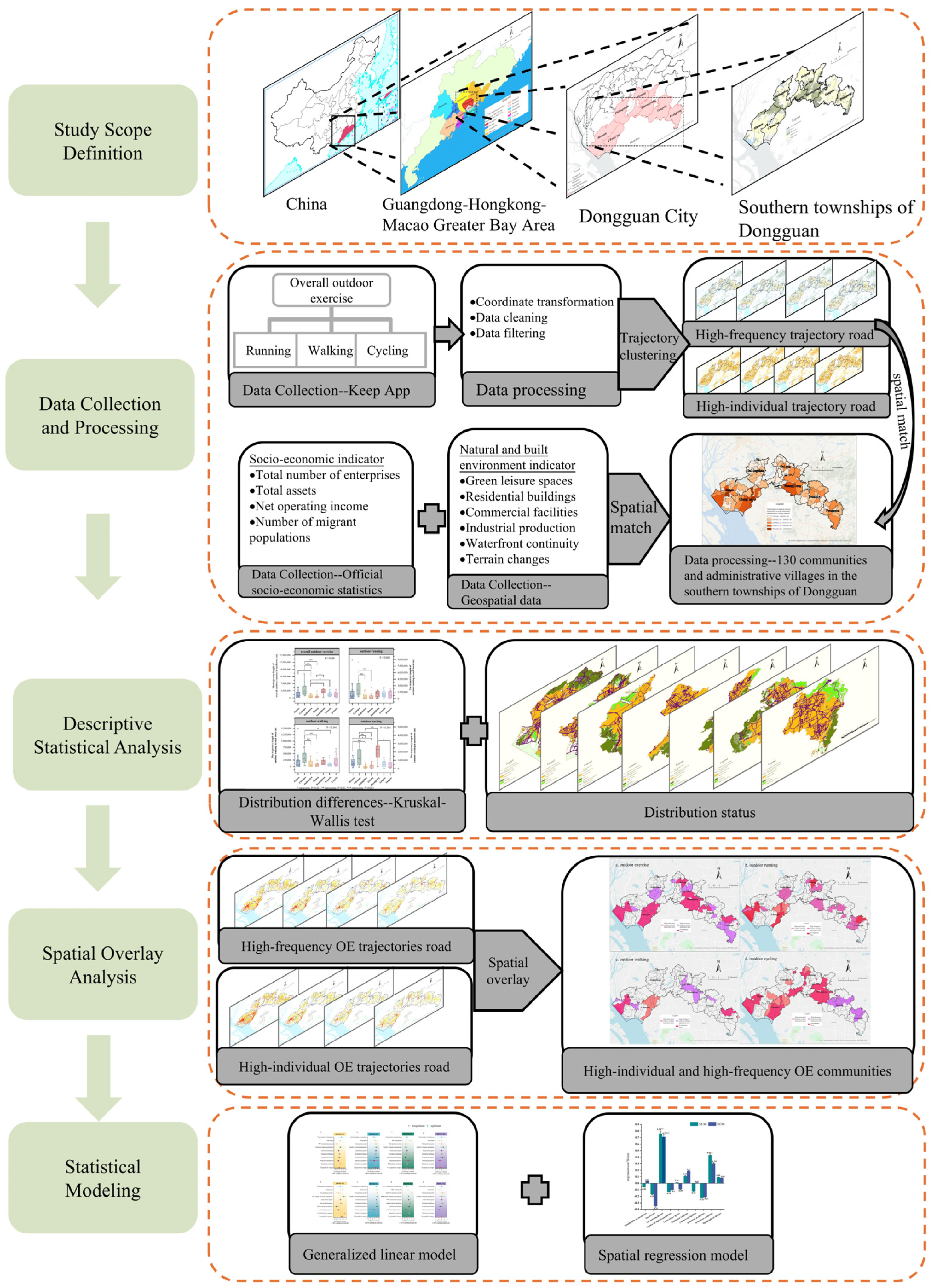
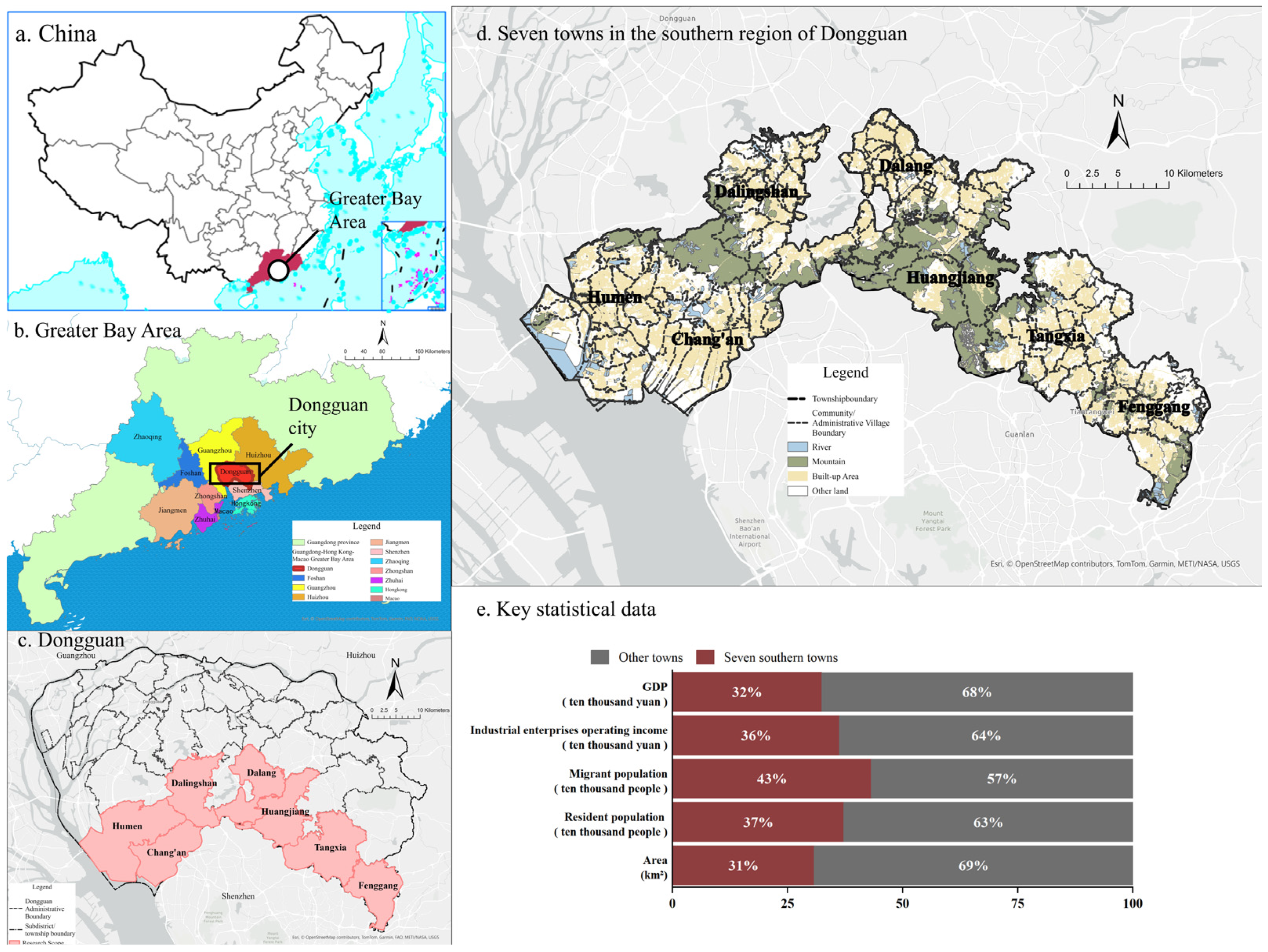
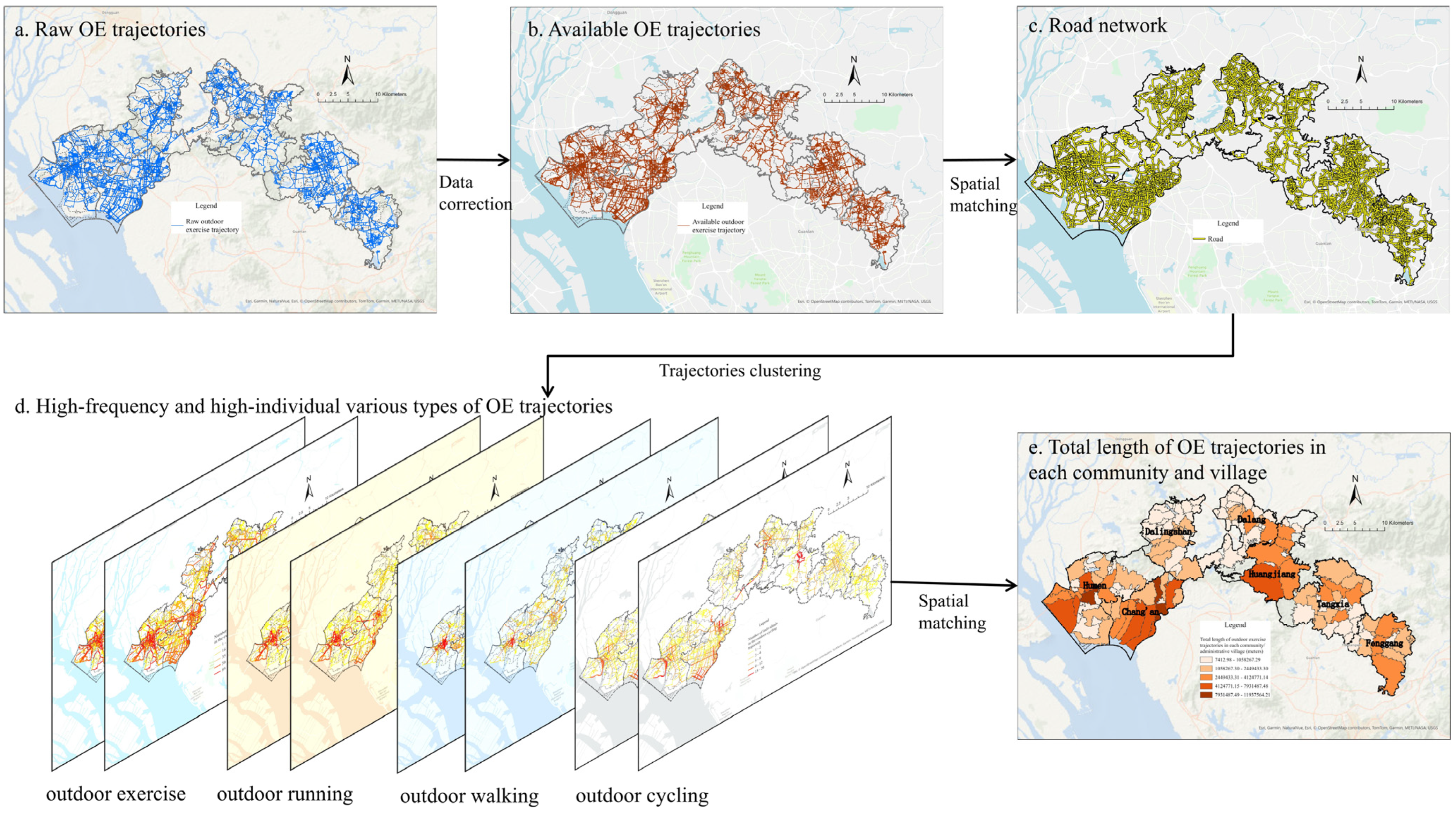

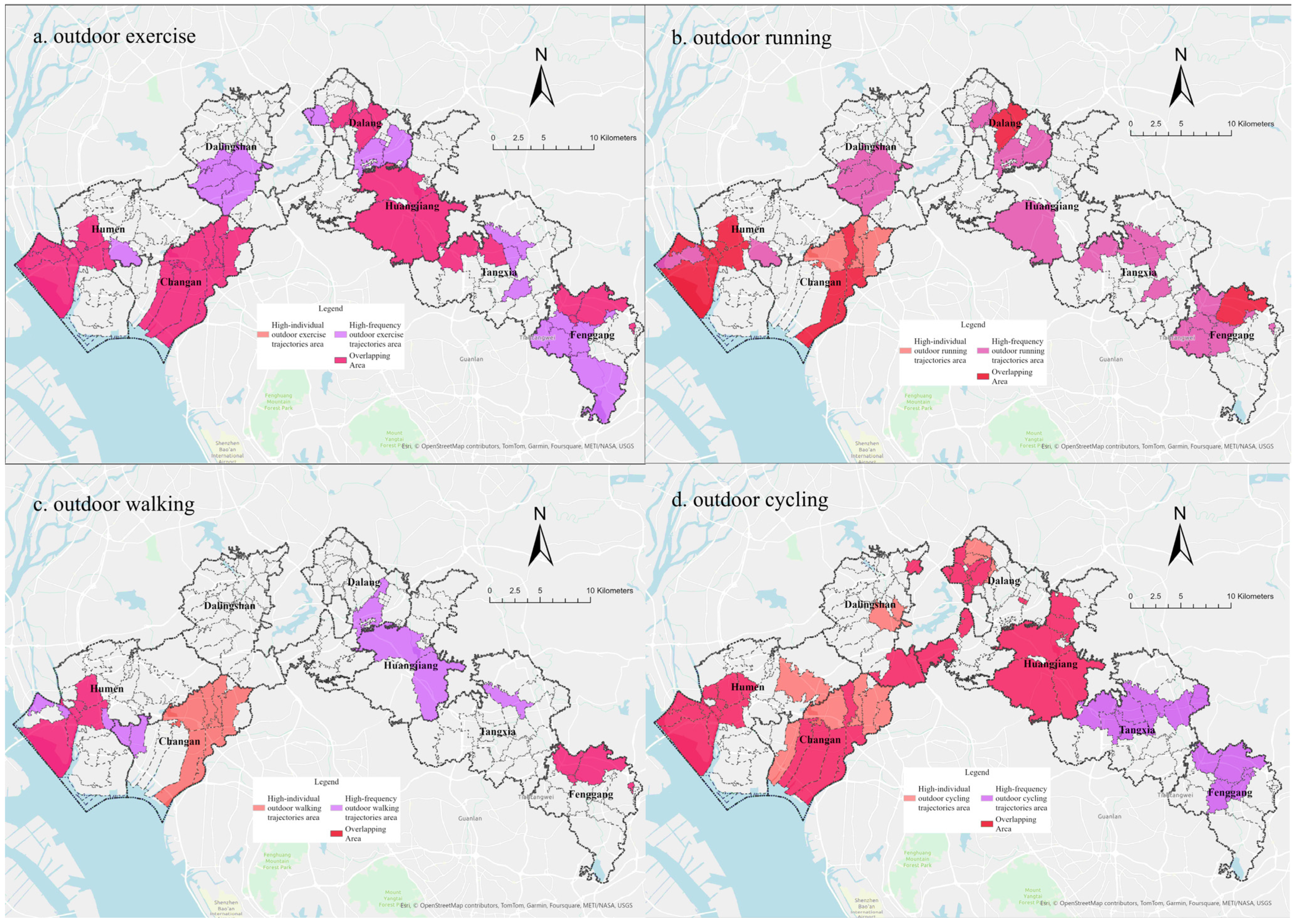
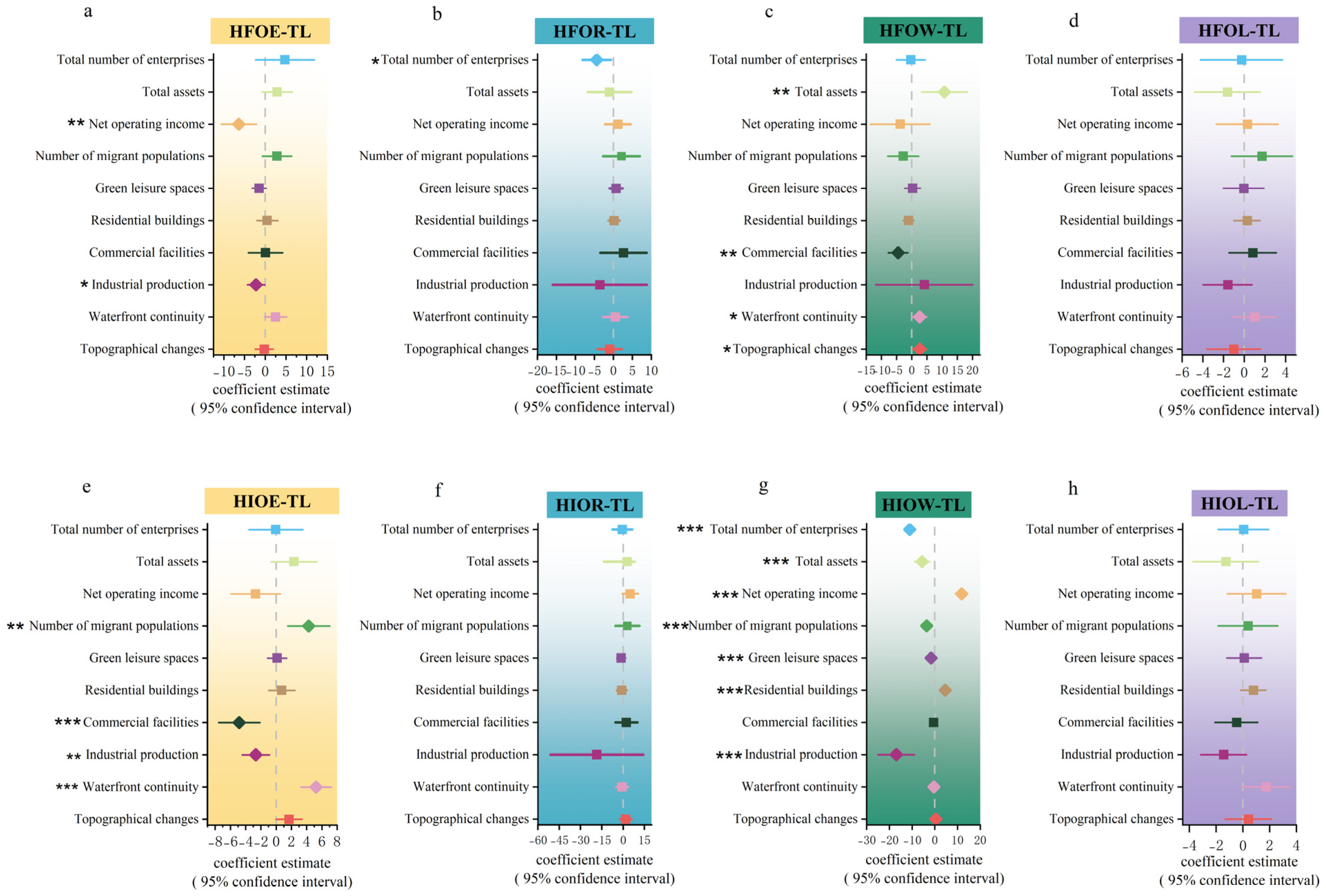
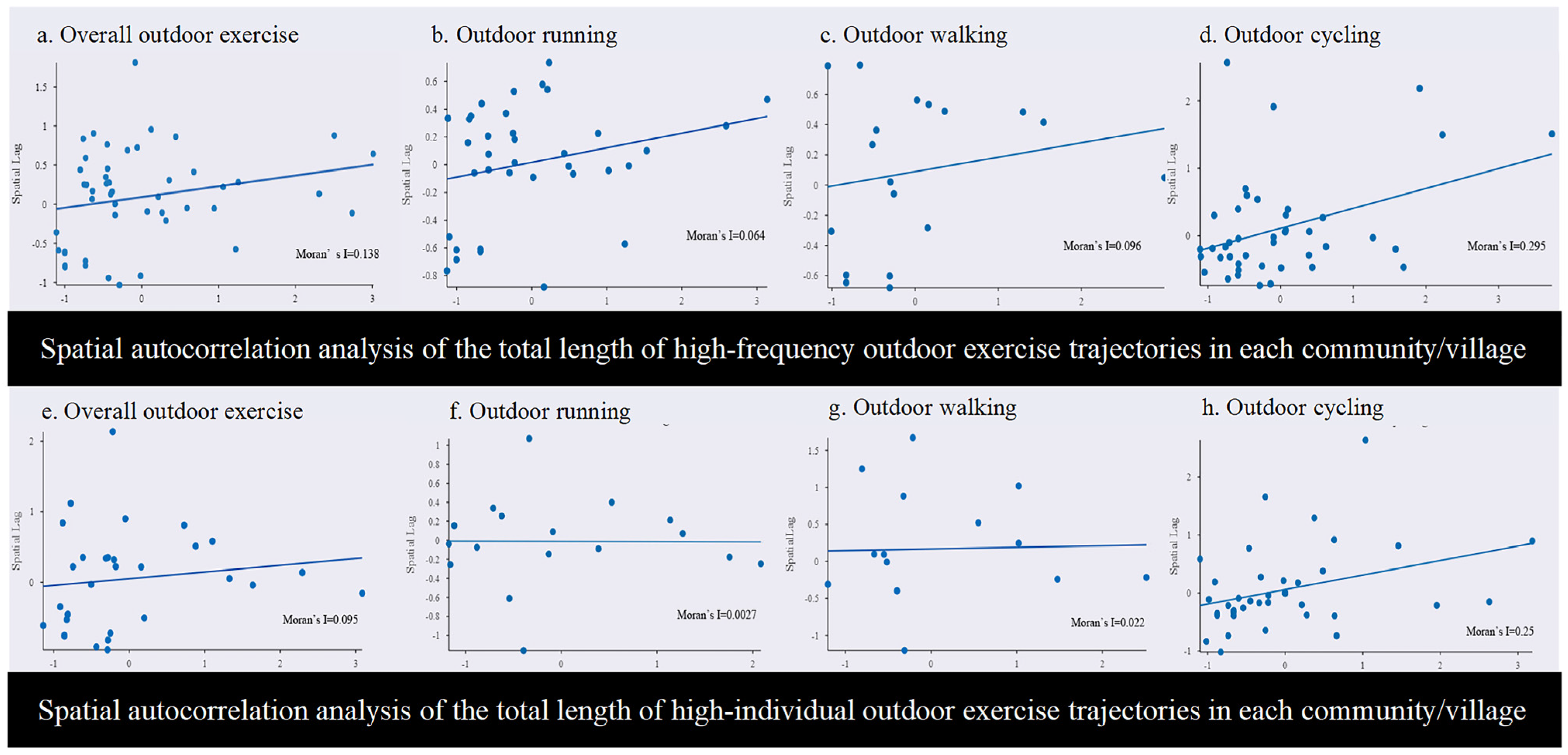
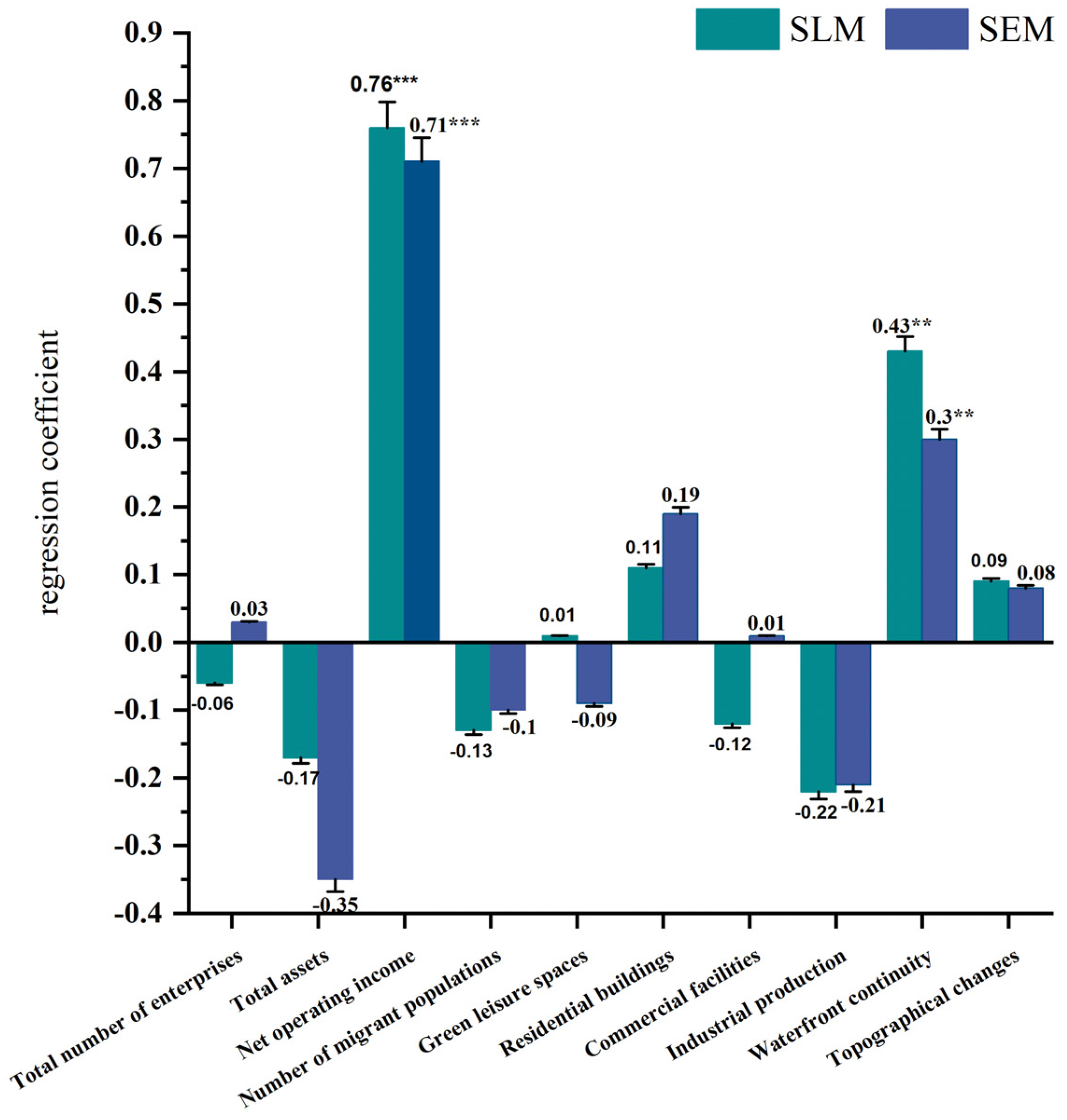
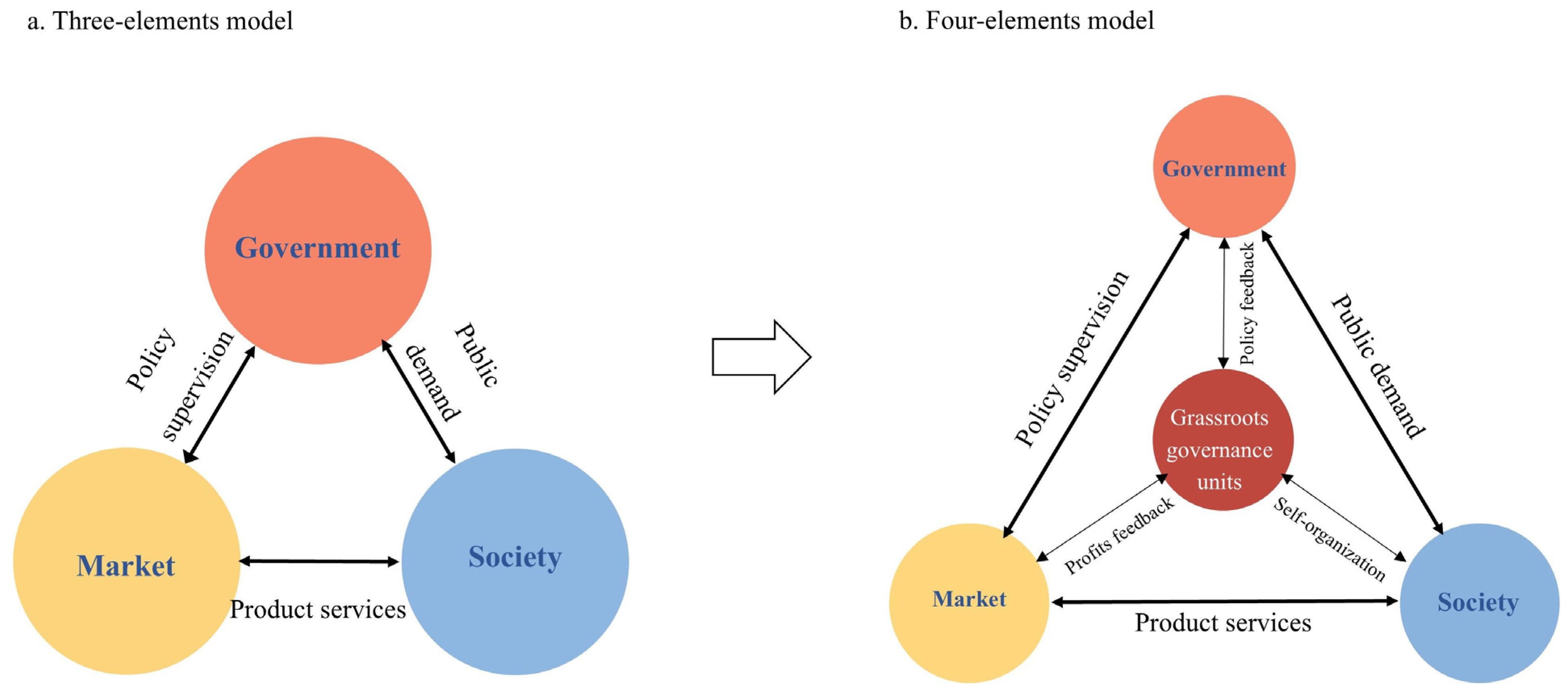
| Dependent Variable | Interpretation and Definition Methods | Minimum | Maximum | Average Value | Standard Deviation |
|---|---|---|---|---|---|
| Total length of high-frequency overall OE trajectories | Total length of overall OE trajectories with a frequency of more than 118 iterations on the same road section | 48.72 | 9189.78 | 485.95 | 1460.21 |
| Total length of high-individual overall OE trajectories | Total length of the trajectories of more than 22 individuals’ overall OE on the same road section | 24.66 | 9852.48 | 414.87 | 1195.70 |
| Total length of high-frequency trajectories for outdoor running | Total length of OR trajectories with a frequency of more than 109 iterations on the same road section | 0.41 | 24.63 | 6.82 | 5.76 |
| Total length of high-individual trajectories for outdoor running | Total length of the trajectories of more than 21 individual OR on the same road section | 0.49 | 22.72 | 8.50 | 7.03 |
| Total length of high-frequency trajectories for outdoor walking | Total length of OW trajectories with a frequency of more than 40 iterations on the same road section | 0.38 | 25.24 | 6.83 | 6.32 |
| Total length of high-individual trajectories for outdoor walking | Total length of the trajectories of more than 8 individual OW on the same road section | 1.22 | 23.88 | 8.56 | 6.30 |
| Total length of high-frequency trajectories for outdoor cycling | Total length of OC trajectories with a frequency of more than 39 iterations on the same road section | 0.94 | 39.66 | 9.79 | 8.10 |
| Total length of high-individual trajectories for outdoor cycling | Total length of the trajectories of more than 9 individual OC on the same road section | 0.53 | 40.23 | 10.22 | 8.85 |
| Dimensions | Variable Name | Data Time | Explanation and Unit | Minimum | Maximum | Average Value | Standard Deviation |
|---|---|---|---|---|---|---|---|
| Socioeconomic status of grassroots governance units | Total number of enterprises | 2022 | Total number of registered enterprises and individual businesses (units) | 39 | 16,087 | 1921.33 | 2224.30 |
| Total assets | 2022 | Total assets (CNY 10,000) | 232 | 457,537 | 55,256.37 | 67,955.14 | |
| Net operating revenue | 2022 | Net operating revenue (CNY 10,000) | 6.22 | 50,830.00 | 6647.98 | 8226.99 | |
| Number of migrant populations | 2022 | Number of migrant populations (persons) | 367 | 183,000 | 31,857.72 | 30,543.34 | |
| Natural and built environment | Green leisure spaces | 2023 | Area of recreational squares and parks (square meters) | 128.00 | 35,542,375.93 | 4,423,520.37 | 10,761,423.56 |
| Residential buildings | 2023 | Total area of residential buildings (square meters) | 235.00 | 1,633,831.11 | 350,386.39 | 418,574.10 | |
| Commercial facilities | 2023 | Total shopping mall area (square meters) | 220,809.28 | 28,370,859.39 | 5,182,036.74 | 4,625,947.88 | |
| Industrial production | 2023 | Total factory area (square meters) | 2320.00 | 9,162,114.66 | 756,651.32 | 1,284,498.01 | |
| Waterfront continuity | 2023 | Total length of natural waterfront continuity (meters) | 0 | 104,106.28 | 17,827.31 | 19,319.56 | |
| Topographical changes | 2023 | The difference between the maximum and minimum elevation (meters) | 20 | 490 | 115.42 | 99.51 |
Disclaimer/Publisher’s Note: The statements, opinions and data contained in all publications are solely those of the individual author(s) and contributor(s) and not of MDPI and/or the editor(s). MDPI and/or the editor(s) disclaim responsibility for any injury to people or property resulting from any ideas, methods, instructions or products referred to in the content. |
© 2025 by the authors. Licensee MDPI, Basel, Switzerland. This article is an open access article distributed under the terms and conditions of the Creative Commons Attribution (CC BY) license (https://creativecommons.org/licenses/by/4.0/).
Share and Cite
Ge, C.; Yang, F.; Wang, H.; Xu, L. Shaping Built Environments for Health-Oriented Physical Activity: Evidence from Outdoor Exercise in Dongguan, China. Buildings 2025, 15, 2812. https://doi.org/10.3390/buildings15162812
Ge C, Yang F, Wang H, Xu L. Shaping Built Environments for Health-Oriented Physical Activity: Evidence from Outdoor Exercise in Dongguan, China. Buildings. 2025; 15(16):2812. https://doi.org/10.3390/buildings15162812
Chicago/Turabian StyleGe, Chao, Fan Yang, Hui Wang, and Linxi Xu. 2025. "Shaping Built Environments for Health-Oriented Physical Activity: Evidence from Outdoor Exercise in Dongguan, China" Buildings 15, no. 16: 2812. https://doi.org/10.3390/buildings15162812
APA StyleGe, C., Yang, F., Wang, H., & Xu, L. (2025). Shaping Built Environments for Health-Oriented Physical Activity: Evidence from Outdoor Exercise in Dongguan, China. Buildings, 15(16), 2812. https://doi.org/10.3390/buildings15162812







